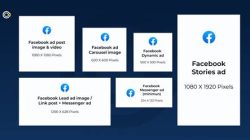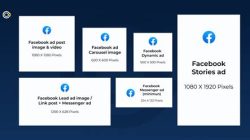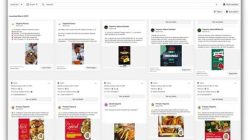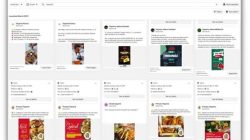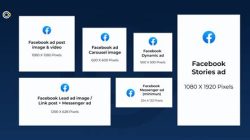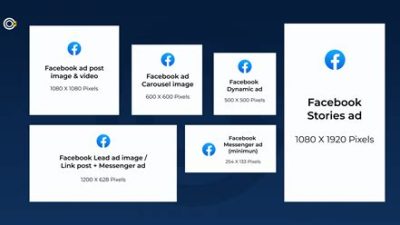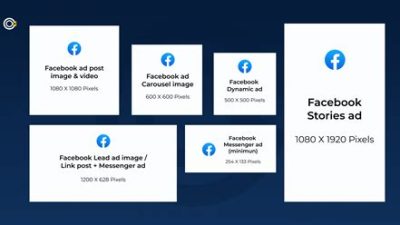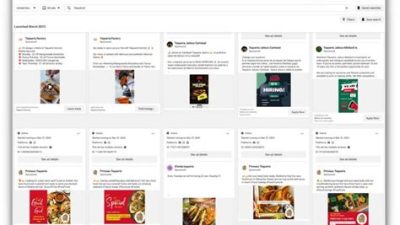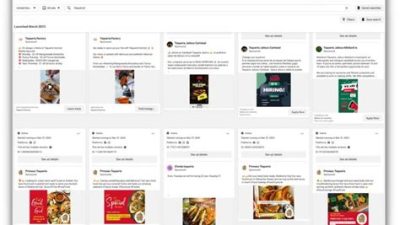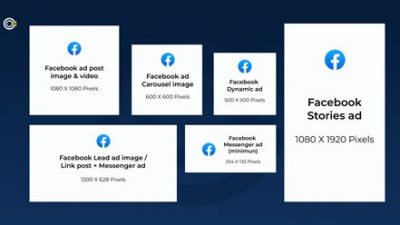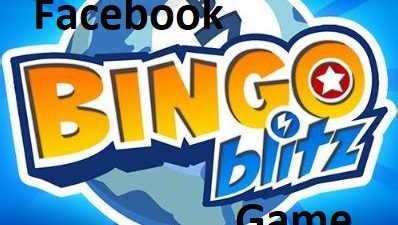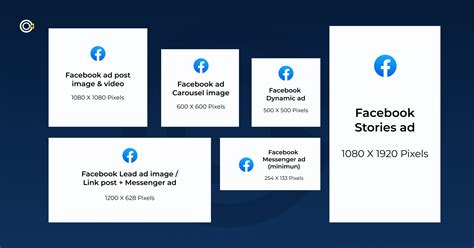
When it comes to advertising on Facebook, getting your ad size right is crucial for making a great impression. With different formats and dimensions available, knowing what works best for your message can make all the difference. Whether you’re showcasing products, driving website traffic, or promoting an event, this guide will walk you through the various Facebook ad sizes, helping your ads look their best and perform effectively. Let’s dive in!
Understanding Facebook Ad Sizes
When it comes to creating effective Facebook ads, understanding the various ad sizes available is crucial. Facebook offers a myriad of ad formats, all of which come with specific dimensions to ensure your ads display correctly across different devices. Each type of ad serves a unique purpose and appeals to different audiences, so it’s essential to know which sizes to use for your campaigns. From image ads to video ads and carousel ads, each format has its own pixel requirements. For instance, a single image ad typically requires a size of 1200 x 628 pixels, while a video ad should ideally be 1280 x 720 pixels. These specifications not only help in maintaining the visual integrity of your ads but also improve their performance, as correctly sized ads are more likely to catch the eye and engage users. Moreover, with the increasing variety of devices—smartphones, tablets, and desktops—understanding these sizes can help ensure that your ads look good no matter where they’re viewed. So, whether you’re a small business owner or a marketer looking to enhance your brand visibility, knowing the ins and outs of ad sizes will give you a solid foundation for your advertising endeavors.
Image Ads: The Foundation of Facebook Advertising
Image ads are perhaps the most common type of advertisement on Facebook, making them a staple for marketers looking to get their messages out. These ads typically feature a single image paired with a compelling caption, call to action, and a link to your website or landing page. The standard ad size for these images is 1200 x 628 pixels, ensuring they display beautifully across mobile and desktop platforms. However, it’s not just about hitting the right size; the imagery itself plays a significant role in capturing attention. Vibrant colors, clear subject matter, and relatable themes can dramatically enhance user engagement. For instance, using lifestyle photos that showcase your product in real-life situations can be effective, as they help potential customers envision the product in their own lives. Furthermore, Facebook has guidelines on text overlay within images; keeping text to a minimum is often more beneficial, as too much text can adversely affect reach and engagement. Always remember that your image is the first thing users will notice, so invest time in crafting an eye-catching visual that encapsulates your brand’s essence.
Video Ads: Engaging Your Audience
Video ads are an increasingly popular choice among marketers looking to engage their audience in a more dynamic way. Unlike image ads, which offer a static viewing experience, video ads bring your content to life with movement, sound, and animation. Facebook recommends keeping video ads short and captivating—ideally around 15 seconds long to retain attention. The ideal size for video ads is 1280 x 720 pixels in a 16:9 ratio, but square videos (1080 x 1080 pixels) can also perform well on mobile devices. Engaging viewers right from the start is critical since the first few seconds can determine whether they continue watching or scroll past. Including captions can also enhance comprehension, particularly since many users watch videos without sound. It’s also worth experimenting with different formats, such as Stories or in-feed videos, to see which resonates best with your audience. Overall, the versatility and impact of video ads can create a more immersive experience for users, driving better engagement and potentially higher conversion rates.
Carousel Ads: Telling a Visual Story
Carousel ads on Facebook provide a unique opportunity to showcase multiple images or videos within a single ad unit. This feature allows advertisers to tell a compelling visual story or display a range of products without overwhelming users with too much information at once. Each card can feature different images or videos, with individual links that can lead consumers to specific product pages or landing sites. The recommended size for carousel images is also 1080 x 1080 pixels, ensuring they remain visually appealing on various screens. Carousel ads are great for promotions, as they allow for a deeper exploration of what you’re offering. An effective approach is to create a narrative flow across the carousel; starting with a strong hook in the first image, followed by complementary visuals that guide users through the story. Furthermore, creativity is key here—consider utilizing cards to highlight customer testimonials, product features, or even step-by-step usage instructions. By engaging users through interactivity, carousel ads not only capture attention but also encourage users to swipe through, increasing the time spent on your content, which can, in turn, positively impact conversions.
Stories Ads: Capturing Instant Engagement
Facebook Stories ads have revolutionized the way brands can reach their audiences. These full-screen ads appear between user-generated stories, providing a unique space where brands can deeply engage with users. With the recommended size of 1080 x 1920 pixels, Stories ads emphasize vertical, mobile-friendly content that mirrors the style of the narratives shared by users. This seamless integration into the Stories format makes advertisements feel less intrusive and more part of the user experience. The ephemeral nature of Stories also adds to their effectiveness; they disappear after 24 hours, providing a sense of urgency for users to engage with the content quickly. Incorporating animated elements, filters, and interactive features such as polls or quizzes can further entice users and create a memorable experience. It’s also an excellent opportunity to share exclusive offers or sneak peeks of upcoming products. By embracing this format, brands can craft authentic connections with their audiences and build excitement around their products or services in a way that’s both dynamic and engaging.
Understanding Facebook Ad Sizes
When creating ads for Facebook, one of the first things to consider is the size of your ads. The right ad size can significantly impact how your content is displayed and how effectively it converts viewers into customers. Facebook offers various ad sizes tailored to different placements, ensuring that you can tailor your ads for optimal performance. Below, we will explore the most common Facebook ad sizes, including image dimensions and format specifications, to help you create eye-catching advertisements.
1. Feed Ads
The most common format you’ll encounter on Facebook is the Feed ad. These ads appear in users’ News Feeds and are designed to blend seamlessly with organic content. Understanding the recommended sizes and formats for Feed ads is crucial for maximizing visibility and engagement.
| Feed Ad Type | Recommended Image Size | Aspect Ratio | Image Format |
|---|---|---|---|
| Single Image | 1200 x 628 pixels | 1.91:1 | JPEG or PNG |
| Carousel | 1080 x 1080 pixels | 1:1 | JPEG or PNG |
| Video | 1280 x 720 pixels | 16:9 | MP4 |
2. Stories Ads
Facebook Stories Ads have gained immense popularity due to their immersive and full-screen nature. This format allows brands to connect with users through short-lived, engaging content. Familiarizing yourself with the specific size requirements for Stories ads will help ensure that your ads display correctly across mobile devices.
| Ad Type | Recommended Image Size | Aspect Ratio | Image Format |
|---|---|---|---|
| Image | 1080 x 1920 pixels | 9:16 | JPEG or PNG |
| Video | 1080 x 1920 pixels | 9:16 | MP4 |
3. Right Column Ads
Although not as commonly used, Right Column ads can still be effective for certain types of campaigns. These ads appear on the right side of the Facebook desktop interface and are smaller than the Feed ads. Understanding the size and type of content that works best in this format can also enhance your overall advertising strategy.
| Ad Type | Recommended Image Size | Aspect Ratio | Image Format |
|---|---|---|---|
| Single Image | 254 x 133 pixels | 1.91:1 | JPEG or PNG |
4. Instant Articles Ads
If you’re utilizing Facebook’s Instant Articles feature, integrating ads is not only possible but highly effective. Instant Articles provide a fast-loading, visually appealing way for users to consume content. The ad sizes are crucial to ensure they fit well within the seamless reading experience.
| Ad Type | Recommended Image Size | Aspect Ratio | Image Format |
|---|---|---|---|
| Image | 1200 x 628 pixels | 1.91:1 | JPEG or PNG |
5. FAQ: Facebook Ad Sizes
What is the best image size for Facebook Feed ads?
The recommended image size for Facebook Feed ads is 1200 x 628 pixels.
Can I use videos in my Facebook ads?
Yes, videos are a great option for Facebook ads, and the recommended size is 1280 x 720 pixels.
What is the aspect ratio for Facebook Stories ads?
The aspect ratio for Facebook Stories ads is 9:16.
Do Right Column ads have a different size requirement?
Yes, Right Column ads have a smaller recommended image size of 254 x 133 pixels.
Are there specific file formats for Facebook ads?
The acceptable formats for images in Facebook ads are JPEG and PNG, while video ads should be in MP4 format.
How many images can I use in a carousel ad?
You can use up to 10 images in a carousel ad on Facebook.
Can text be included in images?
While you can include text in images, it’s best to keep it minimal to avoid ad rejection due to too much text overlay.
What is the maximum length for video ads?
The maximum length for video ads on Facebook is 240 minutes, but shorter videos tend to perform better.
Is there a minimum image size for Facebook ads?
The minimum image size for most ad formats is typically 600 x 600 pixels.
Can I use GIFs in my Facebook ads?
No, Facebook does not allow the use of GIF images in ads, but you can upload videos that animate like GIFs.
How do I ensure my ads are mobile-friendly?
To ensure your ads are mobile-friendly, use responsive designs and adhere to the recommended image sizes for mobile placements.
What should be the focus of the images in my ads?
The images in your ads should focus on the product or service being highlighted and should be eye-catching to grab the user’s attention.
Is A/B testing possible with different ad sizes?
Yes, A/B testing different ad sizes and formats is a great way to determine what works best for your target audience.
Where can I find the latest updates on Facebook ad requirements?
You can find the latest updates on Facebook ad requirements on Facebook’s publisher guidelines and Ads Help Center.
What is the best time to run Facebook ads?
The best time to run Facebook ads varies depending on your target audience, but testing different times can yield insights into optimal performance.
Thanks for Tuning In!
We really appreciate you spending some time with us and diving into the world of Facebook ad sizes. It can be a bit overwhelming, but armed with this info, you can now design ads that stand out and grab attention. Don’t forget to come back later for more tips and tricks to up your marketing game. Until next time, happy advertising!
